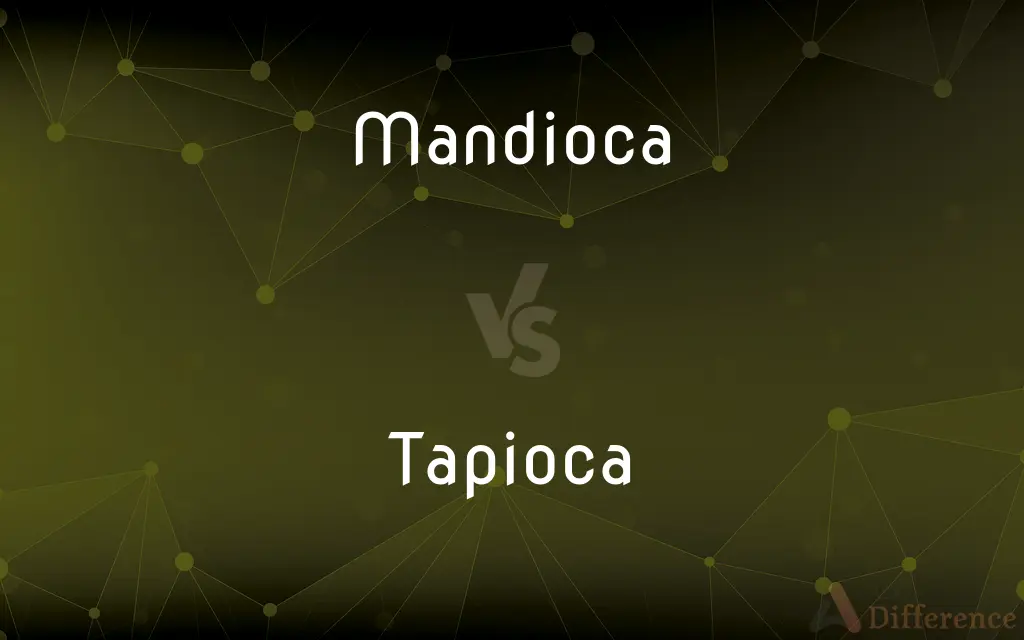Mandioca vs. Tapioca — What's the Difference?
By Tayyaba Rehman & Fiza Rafique — Updated on April 4, 2024
Mandioca, a root vegetable, is the source of tapioca, a starch extracted from the root, highlighting their direct connection yet distinct uses and forms.

Difference Between Mandioca and Tapioca
Table of Contents
ADVERTISEMENT
Key Differences
Mandioca, also known as cassava or yuca, is a tuberous root vegetable native to South America, widely consumed for its carbohydrate content. Tapioca, on the other hand, is the starch extracted from the mandioca root, processed into various forms such as flakes, pearls, and flour. While mandioca is utilized as a whole food, cooked in similar ways to potatoes, tapioca is used as a gluten-free thickening agent and in making puddings, snacks, and bubble tea.
The preparation of mandioca is crucial due to the presence of cyanogenic glycosides, which can be toxic if not properly handled. Tapioca, having been processed to remove these compounds, is safe for consumption in its commercial form. This highlights a significant difference in their culinary uses and safety considerations.
In terms of nutritional content, mandioca is rich in carbohydrates and provides some fiber, vitamins, and minerals. Tapioca, being a refined product, primarily offers carbohydrates with minimal nutritional value otherwise. This distinction underlines mandioca's role as a staple food in many cultures, whereas tapioca is considered more of a culinary ingredient or delicacy.
Culturally, mandioca is a foundational crop in many South American, African, and Asian cuisines, reflecting its versatility and adaptability. Tapioca's cultural significance emerges in its various culinary applications, from Brazilian tapioca crepes to Southeast Asian desserts and the popular bubble tea originating from Taiwan.
The environmental impact and cultivation practices of mandioca are also noteworthy. It is a drought-resistant crop, making it vital for food security in many regions. Tapioca's production involves additional processing steps, which can influence its environmental footprint compared to the direct consumption of mandioca.
ADVERTISEMENT
Comparison Chart
Nature
Root vegetable
Starch extract
Preparation
Requires cooking and proper handling to remove toxins
Processed, safe to consume in commercial form
Nutritional Content
Carbohydrates, fiber, vitamins, minerals
Mainly carbohydrates, minimal other nutrients
Culinary Uses
Eaten as a food staple, similar to potatoes
Used as a thickening agent, in puddings, snacks, bubble tea
Cultural Significance
Staple food in South American, African, Asian cuisines
Varied applications, including Brazilian crepes, Asian desserts
Safety Considerations
Must be properly prepared to remove toxins
Generally safe in processed form
Compare with Definitions
Mandioca
Requires proper preparation to remove toxins.
The mandioca roots were soaked and cooked thoroughly to ensure safety.
Tapioca
Starch extracted from mandioca, used in various culinary applications.
Tapioca pearls are essential for making bubble tea.
Mandioca
Cultivated as a drought-resistant crop.
Mandioca cultivation supports food security in arid regions.
Tapioca
Acts as a gluten-free thickening agent.
Tapioca starch is used to thicken sauces and soups without gluten.
Mandioca
Provides fiber, vitamins, and minerals.
Including mandioca in the diet can contribute to nutritional needs.
Tapioca
Found in forms like pearls, flakes, and flour.
Tapioca flour is a popular ingredient in gluten-free baking.
Mandioca
A tuberous root vegetable, known for its versatility and carbohydrate content.
Mandioca is often boiled or fried as a side dish.
Tapioca
Minimal nutritional value outside of carbohydrates.
While tapioca provides energy, it lacks other nutrients.
Mandioca
Staple food in many cultures.
In Brazil, mandioca flour is used in traditional recipes.
Tapioca
Used in both savory and sweet dishes.
Tapioca pearls add a chewy texture to desserts and drinks.
Mandioca
(obsolete) manioc
Tapioca
Tapioca (; Portuguese: [tapiˈɔkɐ]) is a starch extracted from the storage roots of the cassava plant (Manihot esculenta, also known as manioc), a species native to the north and central-west regions of Brazil, but whose use is now spread throughout South America. The plant was brought by the Portuguese to much of West Indies, Africa and Asia.
Mandioca
Cassava with long tuberous edible roots and soft brittle stems; used especially to make cassiri (an intoxicating drink) and tapioca
Tapioca
A starch made from cassava roots, usually processed as beads or flakes and used for puddings and as a thickening agent in cooking.
Tapioca
A dish, especially a pudding, made from this starch.
Tapioca
A starchy food made from the cassava plant, used in puddings.
Tapioca
The cassava plant, Manihot esculenta, from which tapioca is derived; manioc.
Tapioca
A coarsely granular substance obtained by heating, and thus partly changing, the moistened starch obtained from the roots of the cassava. It is much used in puddings and as a thickening for soups. See Cassava.
Tapioca
Granular preparation of cassava starch used to thicken especially puddings
Common Curiosities
How does tapioca contribute to gluten-free diets?
Tapioca is a preferred thickening agent and flour substitute in gluten-free cooking due to its lack of gluten.
What makes mandioca a staple food in many regions?
Its carbohydrate content, versatility, and drought resistance make it a vital crop for food security.
Is mandioca the same as tapioca flour?
No, tapioca flour is made from mandioca but is a refined starch, different from the whole root.
Can tapioca be used in place of mandioca in recipes?
Tapioca can substitute for mandioca in recipes requiring a thickener or gluten-free flour, but not for dishes where mandioca is used as a whole food.
How are tapioca pearls made?
Tapioca pearls are made by moistening tapioca starch with water, forming it into small balls, and then drying them.
Are there nutritional differences between mandioca and tapioca?
Yes, mandioca provides fiber, vitamins, and minerals, while tapioca primarily offers carbohydrates with minimal other nutrients.
Can you eat tapioca in its natural form?
No, tapioca must be processed from mandioca root and is not consumed in its raw form.
Are there any health risks associated with consuming mandioca?
Yes, if not properly prepared to remove cyanogenic glycosides, it can be toxic.
What's the environmental impact of cultivating mandioca?
Mandioca has a relatively low environmental footprint due to its adaptability to poor soils and resistance to drought.
Why is tapioca popular in bubble tea?
Tapioca pearls provide a chewy texture that contrasts with the sweet, milky tea, making them a hallmark of bubble tea.
Share Your Discovery

Previous Comparison
Flight vs. Sortie
Next Comparison
Nomination vs. ElectionAuthor Spotlight
Written by
Tayyaba RehmanTayyaba Rehman is a distinguished writer, currently serving as a primary contributor to askdifference.com. As a researcher in semantics and etymology, Tayyaba's passion for the complexity of languages and their distinctions has found a perfect home on the platform. Tayyaba delves into the intricacies of language, distinguishing between commonly confused words and phrases, thereby providing clarity for readers worldwide.
Co-written by
Fiza RafiqueFiza Rafique is a skilled content writer at AskDifference.com, where she meticulously refines and enhances written pieces. Drawing from her vast editorial expertise, Fiza ensures clarity, accuracy, and precision in every article. Passionate about language, she continually seeks to elevate the quality of content for readers worldwide.














































